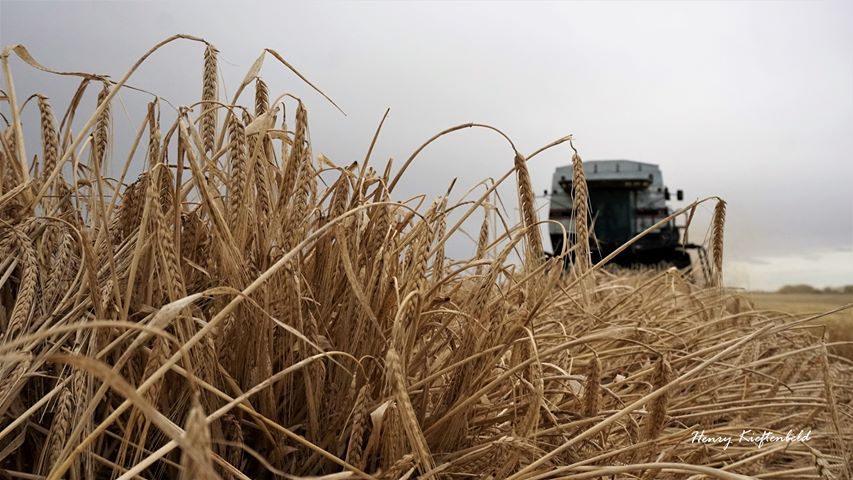Farmers with crops still in the field hope the relatively warm and dry conditions continue for just a while longer as harvest nears completion in Saskatchewan.

Saskatchewan Agriculture reported Thursday that 89 per cent of the 2021 crop is in the bin, ahead of the five-year average of 63 per cent for this time of year.
Another seven per cent of the crop is swathed or ready to straight-cut.
The crop report said the harvest of lentils, field peas and durum is essentially complete, with 94 per cent of the spring wheat, 93 per cent of chickpeas, 89 per cent of barley, 80 per cent of oats and canola, and 64 per cent of barley now combined.
Another 15 per cent of the canola crop is swathed or ready to straight-cut.
Furthest along with the harvest is the southwest region at 94 per cent, followed by the southeast at 92 per cent and the west-central at 89 per cent.
The crop report said the east-central region has 84 per cent combined, the northeast 90 per cent and the northwest 77 per cent.
Famers who have completed their harvest are hoping for rain to rejuvenate topsoil and subsoil moisture levels.
- Honda expected to announce Ontario EV battery plant, part of a $15B investment
- Trudeau says ‘good luck’ to Saskatchewan premier in carbon price spat
- Canadians more likely to eat food past best-before date. What are the risks?
- Hundreds mourn 16-year-old Halifax homicide victim: ‘The youth are feeling it’
Topsoil conditions deteriorated in the past week due to strong winds and a lack of rain.
Sask Ag said most areas of the province did not receive rainfall in the past week, and areas that did see rain did not receive enough to maintain or replenish topsoil moisture.
Topsoil moisture is currently rated 25 per cent adequate, 46 per cent short and 29 per cent very short.
Ag officials said several reports indicate farmers are holding off planning winter cereals due to low topsoil moisture conditions.
Hay and pasture land topsoil moisture are currently rated 16 per cent adequate, 40 per cent short and 44 per cent very short.
Pasture conditions are currently rated seven per cent good, 29 per cent fair, 41 per cent poor and 23 per cent very poor.
Sask Ag said conditions vary across the province, with the southeast and east-central regions in fair-to-good condition due to recent rainfall that helped rejuvenate pasture grass.
The majority of crop damage reported in the past week was caused by wind, frost, waterfowl, wildlife and the lack of moisture.

Relief measures
A number of relief measures have been announced for producers affected by the drought.
The 2021 Canada-Saskatchewan Drought Response Initiative will provide a per-head payment to livestock producers to help maintain female breeding stock.
The initial payment will provide producers $100 per breeding female equivalent in inventory as of Aug. 1, 2021.
Secondary payments of up to $100 per breeding female in inventory as of Dec. 31, 2021, will be made to producers who have incurred additional costs to retain the animals.
The Saskatchewan Crop Insurance Corp. is doubling the low yield appraisal threshold values for its customers who salvage their cereal or pulse crops as feed, without negatively impacting future individual coverage.
SCIC said customers should contact their local office first to discuss options before they graze, bale or silage any damaged crops.
The Saskatchewan government said it is providing relief to livestock producers by temporarily increasing the maximum funding from the Farm and Ranch Water Infrastructure program to $150,000 from $50,000.
The program is for dugouts, wells and pipelines for agriculture use, with the first $50,000 based on a 50-50 cost share and the remaining $100,000 on a 70-30 government-producer cost share.
More information on the program is available by contacting the Agriculture Knowledge Centre at 1-866-457-2377.
The federal and provincial governments have also increased the 2021 AgriStability interim benefit payment percentage from 50 per cent to 75 per cent for Saskatchewan producers.
The interim benefit provides the opportunity for producers enrolled in AgriStability to access a portion of their benefit early, to help support losses and cover costs.
Farmers stress line
Sask Ag said the Farmers Stress Line is available 24 hours a day for any needed support at 1-800-677-4442.
The service is run by Mobile Crisis Services Regina and all calls are confidential.


Comments